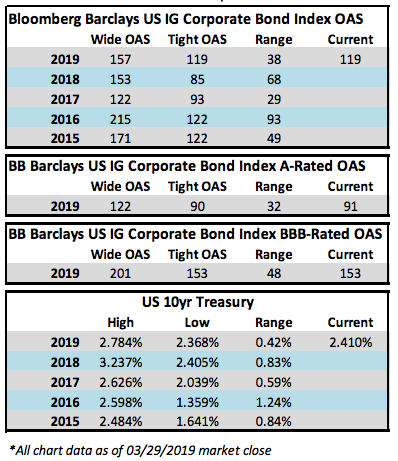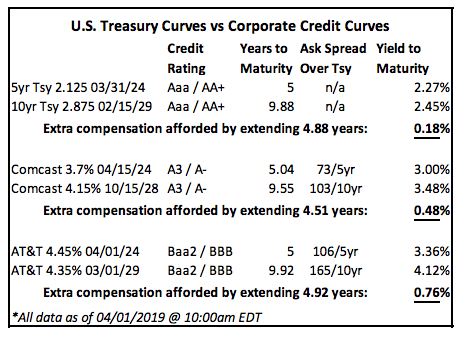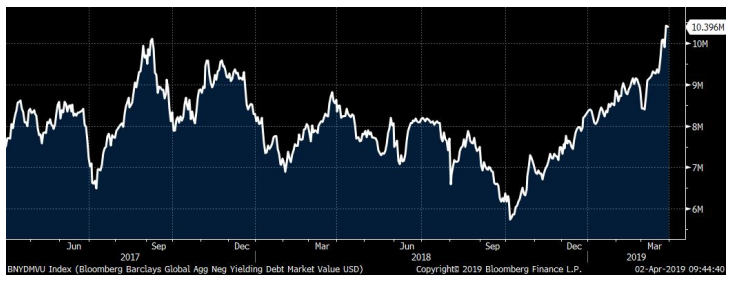2019 Q1 Investment Grade Quarterly
The performance of investment grade credit during the opening quarter of the year was in stark contrast to the final quarter of 2018, as risk assets of all stripes performed well during the first quarter. The spread on the Bloomberg Barclays US Corporate Index finished the quarter 34 basis points tighter, after opening the year at a spread of 153 and closing the quarter at a spread of 119. The one-way spread performance of investment grade credit was so pronounced that at one point in the quarter there was a 22 trading day streak where the market failed to close wider from the previous day.i This was a remarkable feat considering that there were just 61 trading days during the quarter. The 10yr Treasury opened the year at 2.68% and closed as high as 2.79% on January 18th, but it finished the quarter substantially lower, at 2.41%. Tighter spreads and lower rates yielded strong performance for investment grade credit and the Bloomberg Barclays US Corporate Index posted a total return of +5.14%. This compares to CAM’s gross total return of +4.95% for the Investment Grade Strategy.
What a Difference Three Months Makes
When the Federal Reserve issued its December FOMC statement the consensus takeaway by the investor community was an expectation of two rate hikes in 2019 with one additional rate hike thereafter, in 2020 or 2021. In any case, the prevailing thought was that we were nearing the end of this tightening cycle with a conclusion to occur over the next two or three years. The Fed then took the market by surprise in late January, with language that was more conservative than expected as FOMC commentary signaled that they were less committed to raising the Federal Funds Rate in 2019. It was at this point that the market perception shifted – with most investors expecting just one rate hike in the latter half of 2019. The March FOMC statement was yet another eyeopener for Mr. Market, with language even more dovish than the decidedly dovish expectations. The consensus view is now murkier than ever. Some market prognosticators are pricing in rate cuts as soon as 2019; but the more conservative view is that barring a material pickup in global growth or domestic inflation we may not see another increase in the federal funds rate for 6-12 months, if at all in this cycle. It is entirely possible that the current tightening cycle has reached its conclusion and that lower rates could be here to stay.

In the days following the March 20th FOMC release, the 10yr Treasury rallied sharply and there were two days during the week of March 25th where the 90-day Treasury bill closed with a slightly higher yield than the 10yr Treasury. This was the first time that this portion of the yield curve has been inverted since August of 2007. Note that this inversion was very brief in nature and as we go to print at the end of the day on April 1st, the 3m/10yr spread is no longer inverted and is now positive sloping at +17 basis points. That is not to say that this portion of the curve will not invert again, because Treasury rates and curves are dynamic in nature and ever changing.
What Has Happened to Corporate Credit Curves?
This is a common question in the conversations we have had with our investors in recent weeks. Corporate markets are entirely different from Treasury markets and behave much more rationally. The defining characteristic of corporate credit curves is that they nearly always have a positive slope. History shows that corporate credit curves typically steepen as Treasury curves get flatter. There are fleeting moments from time to time where corporate credit curves become slightly inverted but these instances are brief in nature and are quickly erased as market participants are quick to take advantage of these opportunities. For example, there may be a motivated seller of Apple 2026 bonds at a level that offers slightly more yield than Apple 2027 bonds. This has nothing to do with dislocation in the Apple credit curve and everything to do with the fact that there is an extremely motivated seller of the bond that is slightly shorter in maturity. Once that seller moves their position, the curve will return to normalcy and you could once again expect to obtain more yield for the purchase of the 2027 bond than you would for the 2026 bond. The following graphic illustrates current 5/10yr corporate credit curves for two widely traded investment grade companies, one A-rated and one BBB-rated. As you can see, corporate credit curves are much steeper than the spread between the 5 and 10yr Treasury.

The Bottom Line
The takeaway from this exercise is that investors will always be afforded extra compensation by extending out the corporate credit curve. At Cincinnati Asset Management, one of the key tenets of our Investment Grade Strategy is that we believe that it is nearly impossible to accurately predict the direction of interest rates over long time horizons. However, throughout economic cycles, we have observed that the 5/10 portion of the curve is usually the sweet spot for investors. Consequently, the vast majority of our client portfolios are positioned from 5 to 10 years to maturity. We will occasionally hold some positions that are shorter than 5 years but we almost never purchase securities longer than 10 years. Further, while an investor can earn more compensation for credit risk by extending out to 30yrs, more often than not this strategy entails excessive duration risk relative to the compensation afforded at the 10yr portion of the curve. Our strategy allows us to mitigate interest rate risk through our intermediate positioning and allows us to focus on managing credit risk through close study and fundamental analysis of the individual companies that populate our portfolios.

Where in the World is the Yield?
The value of negative yielding global debt hit a multiyear low in October of 2018 but it has exploded since, topping $10 trillion as the sun set on the first quarter, the highest level since September 2017.ii
The growth in negative yielding debt has, in some cases prompted foreign investors to pile into the U.S. corporate debt market. A measure of overseas buying in 2019 has more than doubled from a year earlier according to Bank of America Corp.iii Japanese institutions are among the biggest of the foreign investors and the Japanese fiscal year started on April 1, which could lead to even more buying interest in U.S. corporates according to Bank of America. According to data compiled by the Federal Reserve as of the end of 2018, Non-U.S. investors held 28% of outstanding U.S. IG corporate bonds.iv What does this all mean for the U.S. corporate bond market? First, it is safe to assume that foreign demand certainly played a role in the spread tightening that the investment grade credit markets have experienced year to date. Second, although U.S. rates may seem low, when viewed through the lens of global markets, they are actually quite attractive on a relative basis. As long as these relationships exist then there will be continued foreign interest in the U.S. credit markets.
Although our Investment Grade Strategy trailed the index in the first quarter, we are pleased with the conservative positioning of our portfolio. The modest underperformance can largely be explained by our significant underweight in lower quality BBB-rated credit relative to the index. We do not have a crystal ball, but are reasonably confident that we are in the later stages of the credit cycle so we continue to place vigilance at the forefront when it comes to risk management. Please know that we take the responsibility of managing your money very seriously and we thank you for your continued interest and support.
This information is intended solely to report on investment strategies identified by Cincinnati Asset Management. Opinions and estimates offered constitute our judgment and are subject to change without notice, as are statements of financial market trends, which are based on current market conditions. This material is not intended as an offer or solicitation to buy, hold or sell any financial instrument. Fixed income securities may be sensitive to prevailing interest rates. When rates rise the value generally declines. Past performance is not a guarantee of future results. Gross of advisory fee performance does not reflect the deduction of investment advisory fees. Our advisory fees are disclosed in Form ADV Part 2A. Accounts managed through brokerage firm programs usually will include additional fees. Returns are calculated monthly in U.S. dollars and include reinvestment of dividends and interest. The index is unmanaged and does not take into account fees, expenses, and transaction costs. It is shown for comparative purposes and is based on information generally available to the public from sources believed to be reliable. No representation is made to its accuracy or completeness. See Accompanying Endnotes
i Bloomberg Barclays US Corporate Total Return Value rounded to the nearest hundredth from the close on January 3rd, to the close on February 7th
ii Bloomberg, March 25, 2019, “The $10 Trillion Pool of Negative Debt is Late-Cycle Reckoning”
iii Bloomberg, March 22, 2019, “U.S. Corporate Debt Is on Fire This Year Thanks to Japan”
iv CreditSights, March 8, 2019, “US IG Chart of the Day: Who’s Got the Bonds?”